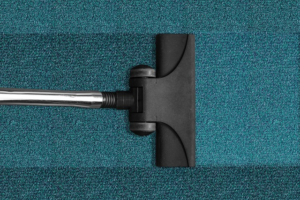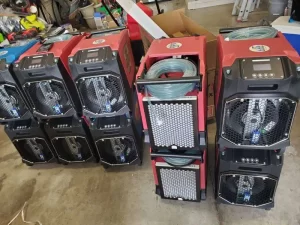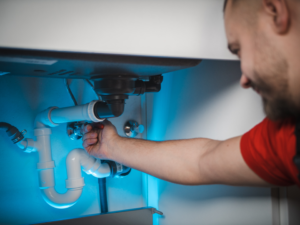Drywall, also known as Sheetrock, is a ubiquitous home building material that is cheap and easy to install. However, it’s also vulnerable to water damage, as the paper backing behind drywall absorbs moisture quite easily. Does wet drywall always need to be replaced? The short answer is – yes.
When water penetrates, it begins to peel off the backing behind your wall, which causes the material to crumble and sag.
While this home construction staple is relatively easy to replace, it’s essential that you get the job done right – and that you ensure the cause of the damage has been thoroughly investigated and fixed.
This is why it’s always a good idea to call TN Flood Kings to assess the issue and address the water damage to keep it from spreading. We’re available 24/7 and provide free estimates, as well as billing directly to your insurance.
Causes of Water Damage in Drywall
Water damage requires a sustained water source that is not immediately stopped and cleaned up. These are some of the most common reasons why you might find damp drywall throughout your home.
Burst Pipes or Leaks
A broken pipe, such as one that freezes and thaws, will release enormous amounts of water throughout the home, including behind the walls and ceilings.
Smaller leaks, though less noticeable, will also lead to wet drywall. These are often worse, as you might not catch it until you notice a spreading water stain on the walls.
Roof Leaks
Roofs are liable to any manner of issues that allow water to penetrate the home. High winds may rip off shingles and flashing, while hail might punch through the layers below the shingles. This all spells serious trouble for your drywall.
Gutter Clogs
Clogged gutters will overflow and send water cascading down the soffit, which connects the exterior walls to the gutters and roof.
High Humidity
Middle Tennessee can get pretty humid in the summer! Annoying as this is for people, it can also cause problems for your home too. Any time there is condensation on the walls or ceiling, you’re liable to experience water damage.
This is also a major reason for drywall damage in bathrooms, kitchens, and laundry rooms, especially those without adequate ventilation.
Risks Associated With Damaged Drywall
Mold Damage
Mold is an insidious pest: it eats away at organic materials in your home, which includes the paper adhered to the drywall. This microorganism also poses health risks for vulnerable individuals, and some strains can even release mycotoxins that poison you.
Structural Problems
Behind your drywall sits the wall studs, which are heavy pieces of timber holding up the structure. Unresolved water will infiltrate and rot these wood studs, which will cause the affected area to lose structural integrity.
Drywall Collapse
While we generally associate drywall with walls, it’s also very common for ceilings, too. If a drywall ceiling gets wet, it is compromised and may suddenly come down. This doesn’t just endanger the structure of the home, but it could also cause serious injury or even death.
Because of the high risk and skill required, this is something you should never tackle on your own. Call TN Flood Kings as soon as possible to get assistance with water damage restoration.
Signs of Wet Drywall
If you haven’t experienced any flooding and you don’t know of any leak, how do you know if your drywall is wet? Some signs, both subtle and obvious, let you know you should replace drywall.
Water Spots or Stains
This is often one of the first signs of trouble, especially on ceilings. Any discoloration of the drywall indicates that it’s been exposed to excess moisture, even if none is obvious on the surface.
Mold Growth
It can hard to tell the difference between mold and water stains, but there’s a fast way to identify which is which: while wearing gloves, run your finger across the surface. If the spot smears, that’s mold.
Peeling Paint
Water damaged drywall can’t hold paint very well, as the paint can no longer adhere to the surface. You might see bubbling or warping, as well as little flakes chipping away.
Moisture or Damp Spots
If your drywall is wet, this means there’s extensive water damage, and you will need to replace all the soaked drywall panels.
Soft walls
Completely dry walls will never be tacky; any time there’s a “give” to your drywall, you have irreparably wet walls.
Sagging or Crumbling Walls
If your walls or ceiling are crumbling or sagging, you need to call TN Flood Kings for drywall replacement immediately. This shows that it’s pulling away from the walls, and it might fall off in sheets at any time. Don’t walk under the water damaged drywall area until you have a professional assess the issue.
When Do You Have to Replace Drywall?
You’re wondering: does wet drywall always need to be replaced? The answer is yes in many cases, but it depends on the extent of the water intrusion and how quickly you can dry things out.
You don’t have to replace drywall if it’s a one-time incident, such as water splashing against the wall that was immediately wiped away and dried. While drywall is relatively porous, it can withstand a little bit of water intrusion without degrading, and won’t need to be replaced for such small-scale damage.
However, if the drywall has been immersed in standing water, or the damage has continued for a long time, it’s likely not possible to save the drywall, and you need drywall replacement.
You should always replace water damaged drywall that came into contact with sewage or flooding, or if there was grey water involved, such as a malfunctioning dishwasher or washing machine.
Hiring Professionals Ensures the Best Possible Replacement
While replacing drywall isn’t necessarily difficult, not all homeowners are comfortable handling this on their own. Drywall replacement requires some specialized skills, such as properly installing drywall screws, and the correct tools. For example, you’ll need a professional dehumidifier, moisture meter, and high volume fans to remove all the water from the area.
TN Flood Kings has years of experience in replacing water damaged drywall, and we will provide full service, including replacing wet insulation, removing mold, and inspecting the area for structural problems. You can call us anytime for a free estimate, and we’ll work with your insurance directly.
How to Dry Out Your Drywall
Even if your drywall doesn’t need to be replaced, it’s pivotal that you start the drying process as soon as possible. Follow these basic steps in order to get your drywall dry.
Find and fix the leak
The last thing you need when you have wet drywall is more water. Before you begin, have a plumber in to identify the cause of the leak and repair it as soon as possible.
Soak up Any Surface Moisture if Necessary
Blot the water damaged wall with towels if there are any wet spots.
Remove the Moisture
For this, you need to get cross ventilation going. Open windows and set up fans aimed at the wet wall. You should also consider getting a dehumidifier and running it in the same room.
Identify the Extent of the Damage
You’ll need to know how much drywall you need to check. Demarcate how much of the wall will have to be taken out with a pencil or chalk.
Inspect for Mold
Now, you’ll want to look for any signs of mold. Don’t just look at the drywall: check out the baseboards and floor too. If you see any, you need to wear protective equipment, such as masks and gloves, so you’re not exposed to dangerous toxins or contact a mold remediation company.
Tips for Preventing Wet Drywall
No one wants to have to replace their drywall: it’s annoying and takes time away from your everyday life. Here are some fast tips for avoiding water damaged drywall.
- Waterproof drywall in high humidity areas to reduce mold risks.
- Run dehumidifiers in any rooms with high humidity, and install exhaust fans in bathrooms and kitchens.
- Purchase a moisture meter to check for any signs of excess moisture.
- Check behind your appliances for any discoloration to the drywall.
- Have your roof inspected regularly.
- Clean out your gutters, or have them replaced if they are damaged.
- Use appliance mats, particularly on second floor appliances.
Struggling With Drywall Water Damage? Call TN Flood Kings 24/7 for a Free Assessment!








